Animation 24 Nov 2007 09:08 am
Intvw – JRDilworth
John R. Dilworth is a good friend. He’s currently in Europe putting together some interesting animation projects. He sent me a copy of this interview which was conducted by Andrew La Punta from the School of Visual Arts. Since I was thinking of writing about John, myself, I’ll post this interview for now to give John some due attention.
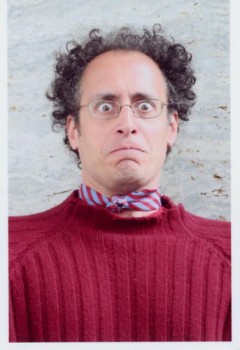 When did you first realize you wanted to pursue animation as your career?
When did you first realize you wanted to pursue animation as your career?
The moment appeared in the form of a sudden shock to my psyche experimenting with children book illustrations. I was reviewing a few illustrations I had done for an unpublished author on spec; this was before my study at SVA, and I thought to myself, quite unexpectedly, I would love to see this move. That was it.
How did you first start out in the animation field?
I began my animation career during study at SVA. I would go to the jobs board and apply for the listings that appealed to me. Among my favorite was animating a greeting card flip book. It was produced and distributed and brought me satisfaction, including a life friend of the producer. When I was not doing homework, or “freelance” as a student, I would make animated films. I made 3 during SVA. One of them, my graduation film, Pierre 1985, I used to show producers in the industry. I simply called all the studios I could and made appointments for portfolio review. This was a difficult period. I worked in advertising until I was able to earn enough to work in animation full time. It took me nearly two years. My first jobs in animation were in production. I accepted any job offered me. I hand painted cels, worked in production, interned for Howard Beckerman. I joined animation groups like ASIFA. I volunteered with these groups. I made an effort to meet artists and producers. I traveled to take “tests” in Los Angeles and Florida. I made phone calls in these cities to producers and artists and introduced myself. 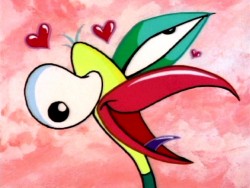 This was a very tough process as I am a modest and shy individual by nature. I had forced myself to “break on through to the other side” of this to give myself a better chance. Eventually, I was given assisting and inbetween work. Then animation. I was reading and studying motion and the fundamentals of movement. I liked attending dance performances. The kinetic energy of dance stimulated my impulses to “dance” on paper. And throughout this process of development, I made my own animation art. When I produced the Dirdy Birdy in 1994, I was moving into the next level of making animation and earning a living solely based on my work.
This was a very tough process as I am a modest and shy individual by nature. I had forced myself to “break on through to the other side” of this to give myself a better chance. Eventually, I was given assisting and inbetween work. Then animation. I was reading and studying motion and the fundamentals of movement. I liked attending dance performances. The kinetic energy of dance stimulated my impulses to “dance” on paper. And throughout this process of development, I made my own animation art. When I produced the Dirdy Birdy in 1994, I was moving into the next level of making animation and earning a living solely based on my work.
What are some difficulties you face as an animator?
Currrently, the biggest difficulties are finding the most complimentary relationships with producers and distributors, raising the funding to make animation, back-end participation and technology’s influence on hand drawn animation in the market.
What methods do you use to look for inspiration?
In the past, I was in a kind of undeclared art therapy. I used semi-autobiographical material 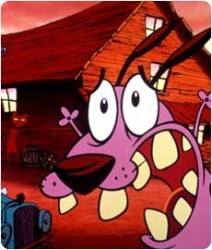 such as my relationship with family and society ( Smart Talk with Raisin ), lovers ( When Lily Laney Moved In, The Limited Bird, N&N, Catch of the Day), my own dysfunctional behavior ( The Dirdy Birdy, The Mousochist, Courage the Cowardly Dog ) or personal collisions ( Life in Transition ). These themes tend to be my current sources of influence today as well, now that I think it over. My method of inspiration is introspection, self-inquirery and a pursuit to understand the universe. Only once did an illustration I admired in a catalog of erotic art inspire a short film, and of course I cannot discount the method of sitting back and watching great films and cartoons. I would often make notes on those aspects of this “viewing” that inspired something in me.
such as my relationship with family and society ( Smart Talk with Raisin ), lovers ( When Lily Laney Moved In, The Limited Bird, N&N, Catch of the Day), my own dysfunctional behavior ( The Dirdy Birdy, The Mousochist, Courage the Cowardly Dog ) or personal collisions ( Life in Transition ). These themes tend to be my current sources of influence today as well, now that I think it over. My method of inspiration is introspection, self-inquirery and a pursuit to understand the universe. Only once did an illustration I admired in a catalog of erotic art inspire a short film, and of course I cannot discount the method of sitting back and watching great films and cartoons. I would often make notes on those aspects of this “viewing” that inspired something in me.
In the past, animators would have to paint cels and shoot frames on a camera. Today, 2d animation is mostly digital. What are your thoughts about the direction 2d animation has taken?
My last hand painted film on cels was The Dirdy Birdy (1994). I embraced the new technology to paint and compose hand drawn animation in the computer, I believed that I could manage my films better than having to delegate. On my next film, The Chicken from Outer Space (1995 ), I out-sourced the Ink & Paint to the Animo software system and later transfered to film directly from digital files. Currently, I do not have a personal relationship of expression using FLASH, for instance. I do not “feel” the human uniqueness of spontaneity and sudden and impetuous diversion in line and motion that characterized, in part, the struggle of traditional animation. However, I freelance the duties of AFX. FLASH or Photoshop to artists who have the facility and I continue to enjoy hand drawing. I am aware 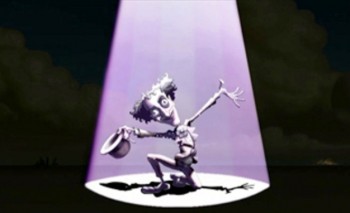 that the substance of a project should be awarded the medium in which to best express it. I would not have enjoyed watching Tex Avery or Bob Clampett cartoons in FLASH. However, the “look” of the creative stuff coming out of these softwares are itself a unique thing and the current market appears to demand it. That is itself a validation of direction the overall medium is taking. What I do wish would return is the mentor/protege model of experience. The new softwares tend to isolate the individual from the intra-personal group experience. Talent do not even read the manuals. I’ve noticed that they go solo and learn the vocabulary built in the software.
that the substance of a project should be awarded the medium in which to best express it. I would not have enjoyed watching Tex Avery or Bob Clampett cartoons in FLASH. However, the “look” of the creative stuff coming out of these softwares are itself a unique thing and the current market appears to demand it. That is itself a validation of direction the overall medium is taking. What I do wish would return is the mentor/protege model of experience. The new softwares tend to isolate the individual from the intra-personal group experience. Talent do not even read the manuals. I’ve noticed that they go solo and learn the vocabulary built in the software.
What are your thoughts about the future of 2d animation? Will it eventually fade away, be replaced with 3d animation, or stay forever?
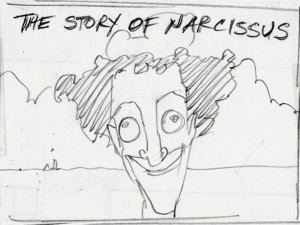 The market is king. Currently, the market is investing heavily in computer animation and 3-D without glasses. These are advances in a visual medium that rival the technological revolution upon the release of “Snow White”. That’s the commercial consideration and human necessity for invention and “progress”. The future for me will always include hand drawn animation. I continue to offer the market my talent and continue to make my art by hand. If I can no longer afford to make animated films by hand, for instance, I will probably do something else. The most important thing to remember is simply do what you enjoy the most and what brings you the most satisfaction, like masturbation. And I am a master at pleasing myself!
The market is king. Currently, the market is investing heavily in computer animation and 3-D without glasses. These are advances in a visual medium that rival the technological revolution upon the release of “Snow White”. That’s the commercial consideration and human necessity for invention and “progress”. The future for me will always include hand drawn animation. I continue to offer the market my talent and continue to make my art by hand. If I can no longer afford to make animated films by hand, for instance, I will probably do something else. The most important thing to remember is simply do what you enjoy the most and what brings you the most satisfaction, like masturbation. And I am a master at pleasing myself!
At the end of the day, do you have any regrets with your decision on becoming an animator?
No, I have no regrets becoming an animator. I do have regrets over my attitude as an animator towards certain producers and network executives. I would have liked to react to the outrage I had to endure with more gallantry. I regret that I allowed my pride to reign over civility. I regret that I allowed myself to be truculent in attitude, aggressive in opinion and arrogant to ideas and perceived ignorance of others, even to the deliberate greed and megalomanic insecurities of these characters. These incredulous acts of my self-defeatism 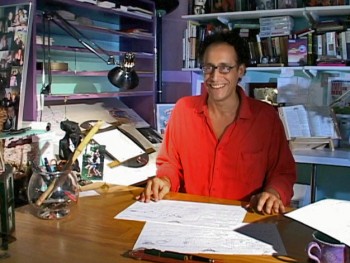 contributed to a diminished reward, the reward of enjoying the moment of conflict and creation. No, I have no regrets becoming an animator, only the regret that I did not make a better effort to be a gentleman animator. However, I must accept that the chemistry of deep passion for my art will contrive with my irrational reactions yielding something beyond my control, like one of my favorite militants in cartoons, Daffy Duck.
contributed to a diminished reward, the reward of enjoying the moment of conflict and creation. No, I have no regrets becoming an animator, only the regret that I did not make a better effort to be a gentleman animator. However, I must accept that the chemistry of deep passion for my art will contrive with my irrational reactions yielding something beyond my control, like one of my favorite militants in cartoons, Daffy Duck.

on 24 Nov 2007 at 6:49 pm 1.Mark Mayerson said …
Hmm. There seems to be a story about Dilworth’s relationships with the higher-ups. I can guess what it was. While he seems to think that he handled it badly, I wonder if he’s right. The alternative is to smile as they keep adding water to the soup, and while that might preserve your relationship, what good does it do for the work?
on 25 Nov 2007 at 10:28 am 2.Dave Levy said …
We should resist the temptation to assume that execs are always wrong and creators ought to be left alone. Healthy relationships can’t be undervalued in such a collaborative artform as animation, especially when it concerns relationships with the hand that feeds you (in John’s case, the networks/executives). Both parties have the obligation and responsiblity to make it work.
I’m always shocked when creators take the point of view that they are okay with networks spending millions on them, but don’t think that ought to be accompinied by network notes or input. To those people, I say, make only independent films and you won’t have to answer to anyone.
John is such a hero to me because he’s made a tremendous impact as both a series creator and as an independent filmmaker. My own idea of success is a similar blend of the two worlds.
This was a great and honest interview. Thanks for posting it, Michael!
on 26 Nov 2007 at 9:08 am 3.Mark Mayerson said …
So people who are paying for brain surgery should collaborate with their doctors on where to place the scalpel?
on 26 Nov 2007 at 10:07 am 4.Dave Levy said …
Networks have an agenda and they have a right to it. It doesn’t mean they will always be smart or right. Come to think of it, creators aren’t always brilliant or right. Working with a network is just like creating art in other commerical areas. An illustrator hired to do a magazine spot works with the magazine, it’s art director, editor, and so on… Any artist working commercially should be used to this by now.
The alternative is to work completely free of commericial considerations. While that sounds like fun, it sure would be hard to pay the rent.
on 03 Dec 2007 at 11:01 pm 5.Drew Silverman said …
Andrew did a great job at this interview. I miss him.
on 28 Jan 2019 at 2:31 pm 6.Vivian McAlexander said …
I love John Dilworth and his wonderful and amusing work. As a cartoonist and artist, he is a great inspiration to me, as is Ed “Big Daddy” Ed Roth, John Kricfalusi, and the classic Looney Tunes animators.